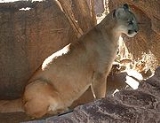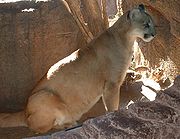
Arizona-Sonora Desert Museum
Encyclopedia
The Arizona-Sonora Desert Museum is a 98 acres (40 ha) museum and zoo founded in 1952 and located in Tucson, Arizona
. It contains a museum and two miles (3.2 km) of walking paths on 21 acres (8.5 ha) of this property, and is one of the most visited attractions in Tucson. The facility combines the attractions of a zoo
, museum
, and botanical garden
, with a focus is the plants and animals that live in the Sonoran Desert
, and it was a pioneer in the creation of naturalistic enclosures for its animals.
The museum is an accredited member of the Association of Zoos and Aquariums
(AZA), and attracts over 500,000 visitors each year.
The site chosen for the facility was 12 miles (19.3 km) West of Tucson—98 acres (39.7 ha) of mostly natural desert with some structures originally constructed by the Civilian Conservation Corps and known as the "Mountain House." The land, then and now, was owned by Pima County and leased to the museum. The first board of trustees was not formed until months after the facility was opened, and one of its first acts was to change the name to Arizona-Sonora Desert Museum.

of the Sonoran Desert
.
Tucson, Arizona
Tucson is a city in and the county seat of Pima County, Arizona, United States. The city is located 118 miles southeast of Phoenix and 60 miles north of the U.S.-Mexico border. The 2010 United States Census puts the city's population at 520,116 with a metropolitan area population at 1,020,200...
. It contains a museum and two miles (3.2 km) of walking paths on 21 acres (8.5 ha) of this property, and is one of the most visited attractions in Tucson. The facility combines the attractions of a zoo
Zoo
A zoological garden, zoological park, menagerie, or zoo is a facility in which animals are confined within enclosures, displayed to the public, and in which they may also be bred....
, museum
Museum
A museum is an institution that cares for a collection of artifacts and other objects of scientific, artistic, cultural, or historical importance and makes them available for public viewing through exhibits that may be permanent or temporary. Most large museums are located in major cities...
, and botanical garden
Botanical garden
A botanical garden The terms botanic and botanical, and garden or gardens are used more-or-less interchangeably, although the word botanic is generally reserved for the earlier, more traditional gardens. is a well-tended area displaying a wide range of plants labelled with their botanical names...
, with a focus is the plants and animals that live in the Sonoran Desert
Sonoran Desert
The Sonoran Desert is a North American desert which straddles part of the United States-Mexico border and covers large parts of the U.S. states of Arizona and California and the northwest Mexican states of Sonora, Baja California, and Baja California Sur. It is one of the largest and hottest...
, and it was a pioneer in the creation of naturalistic enclosures for its animals.
The museum is an accredited member of the Association of Zoos and Aquariums
Association of Zoos and Aquariums
The Association of Zoos and Aquariums was founded in 1924 and is a nonprofit organization dedicated to the advancement of zoos and public aquariums in the areas of conservation, education, science, and recreation.The AZA headquarters is located in Silver...
(AZA), and attracts over 500,000 visitors each year.
History
The ASDM was created by William Carr and Arthur Pack and opened in 1952 as the "Arizona-Sonora Desert Trailside Museum." It was one of the first naturalistic zoos in the United States. The founders originally found a lot of opposition due to the local concept at the time of a zoo as "terrible, little roadside snakefarms."The site chosen for the facility was 12 miles (19.3 km) West of Tucson—98 acres (39.7 ha) of mostly natural desert with some structures originally constructed by the Civilian Conservation Corps and known as the "Mountain House." The land, then and now, was owned by Pima County and leased to the museum. The first board of trustees was not formed until months after the facility was opened, and one of its first acts was to change the name to Arizona-Sonora Desert Museum.

Programs
The zoo has a Junior Docent program, in which teens 13-18 years old can learn about the plants and animals at the museum. Junior Docent volunteer one day each weekend to present certain Sonoran Desert-related information to museum visitors.Education
The Center for Sonoran Desert Studies, founded in 2005, conducts the educational and scientific functions of the Museum and is a hub for research, education and conservationConservation biology
Conservation biology is the scientific study of the nature and status of Earth's biodiversity with the aim of protecting species, their habitats, and ecosystems from excessive rates of extinction...
of the Sonoran Desert
Sonoran Desert
The Sonoran Desert is a North American desert which straddles part of the United States-Mexico border and covers large parts of the U.S. states of Arizona and California and the northwest Mexican states of Sonora, Baja California, and Baja California Sur. It is one of the largest and hottest...
.

